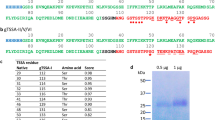Summary
Amoebiasis, caused by an enteric protozoanEntamoeba histolytica, is one of the major parasitic diseases of mankind. Current estimate suggests that the parasite infects about 10% of the world population at any given time. There is an urgent need to characterize the antigenic molecules ofE. histolytica, and find out antigens which have both immunodiagnostic and prophylactic potential against amoebiasis. The results of somatic antigen analysis, using sera from immune or infected individuals, indicated that the wholeE. histolytica trophozoites, are highly complex and heterogeneous in nature and both immunodiagnostic and immuno prophylaxis activity remain mainly in a surface associated 29 kDa glycoprotein ofE. histolytica. Future studies at molecular level particularly, genes responsible for expression of this protein, their homology with other proteins and structure analysis will give better understanding about this polypeptide. Studies on excretory secretory antigens, clearly demonstrated thatE. histolytica like many organisms, also liberates certain antigenic moieties into the culture medium during in vitro cultivation and this antigen has similar diagnostic values like the conventional somatic antigens. It is important that the ESA should be prepared from the supernatant after collecting the cell and use for immunodiagnosis of amoebiasis. This is an additional source of antigen which will help in carrying out more tests using the same reagents. Further studies are needed to clarify the location of these molecules on the parasite, along with detailed biochemical and immunological characterization and their relation with the pathogenesis.
Similar content being viewed by others
References
Walsh, J.A. (1986) Problems in recognition and diagnosis of amoebiasis: Estimation of the global magnitude of morbidity and mortality. Rev. Infec. Dis. 8, 228–238.
Joshi, C.K., Bharadwaj, A.K. and Vyas, B.L. (1980) Intestinal parasites in slum dwellers. Ind. J. Med. Assoc. 75, 156–159.
Das, P., Sengupta, K., Pal, S., Das, D. and Pal, S.C. (1993). Biochemical and immunological studies on soluble antigens ofEntamoeba histolytica. Parasitol. Res. 79, 365–371.
Sengupta, K., Das, P., Johnson, T.M., Chaudhuri, P.P., Das, D. and Nair, G.B. (1993). Production and characterization of monoclonal antibodies against a highly immunogenic fraction ofEntamoeba histolytica (NIH: 200) and their application in the detection of current amoebic infection. J. Eukry. Microbiol. 40, 722–726.
Pal, S., Das, P., Ghose, A.C. and Pal S.C. (1984) A preliminary report on the Excretory Secretory antigen(s) ofE. histolytica. IRCS Medical Science 2, 616–618.
Pal, S., Sarkar, S., Sengupta, K. and Das, P. (1996) Comparative evaluation of excretory-secretory and somatic antigens ofE. histolytica in serodiagnosis of human amoebiases. Ind. J. Med. Res. 104, 152–156.
Author information
Authors and Affiliations
Additional information
This was presented at the symposium on “Recent Trends in Tropical Disease Research”, held at Sevagram on 5-6 September, 1997.
Rights and permissions
About this article
Cite this article
Bhattacharya, S., Sengupta, K., Sengupta, S. et al. Antigens of diagnostic and prophylactic importance inEntamoeba histolytica . Indian J Clin Biochem 13, 33–35 (1998). https://doi.org/10.1007/BF02873440
Issue Date:
DOI: https://doi.org/10.1007/BF02873440




